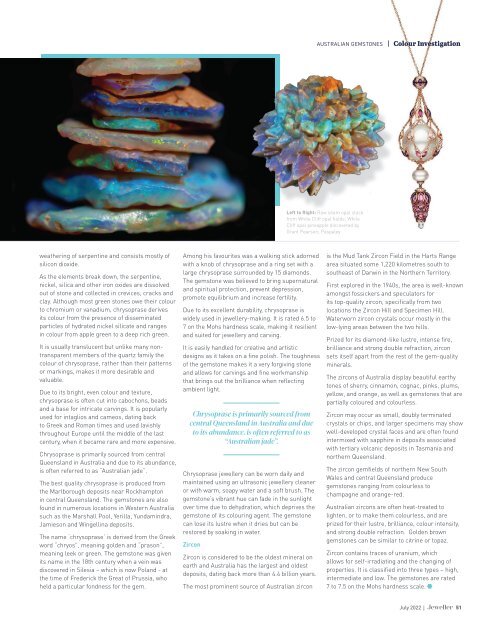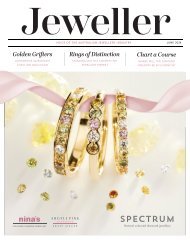Jeweller - July 2022
Door wide open: Lab-grown diamonds have a unique chance to thrive The Ego Game: Personalised jewellery is as popular as ever seen Avoid the trap: The business world is full of cliches - it's time to move on
Door wide open: Lab-grown diamonds have a unique chance to thrive
The Ego Game: Personalised jewellery is as popular as ever seen
Avoid the trap: The business world is full of cliches - it's time to move on
You also want an ePaper? Increase the reach of your titles
YUMPU automatically turns print PDFs into web optimized ePapers that Google loves.
AUSTRALIAN GEMSTONES | Colour Investigation<br />
Left to Right: Raw seam opal stack<br />
from White Cliff opal fields; White<br />
Cliff opal pineapple discovered by<br />
Grant Pearson; Paspaley<br />
weathering of serpentine and consists mostly of<br />
silicon dioxide.<br />
As the elements break down, the serpentine,<br />
nickel, silica and other iron oxides are dissolved<br />
out of stone and collected in crevices, cracks and<br />
clay. Although most green stones owe their colour<br />
to chromium or vanadium, chrysoprase derives<br />
its colour from the presence of disseminated<br />
particles of hydrated nickel silicate and ranges<br />
in colour from apple green to a deep rich green.<br />
It is usually translucent but unlike many nontransparent<br />
members of the quartz family the<br />
colour of chrysoprase, rather than their patterns<br />
or markings, makes it more desirable and<br />
valuable.<br />
Due to its bright, even colour and texture,<br />
chrysoprase is often cut into cabochons, beads<br />
and a base for intricate carvings. It is popularly<br />
used for intaglios and cameos, dating back<br />
to Greek and Roman times and used lavishly<br />
throughout Europe until the middle of the last<br />
century, when it became rare and more expensive.<br />
Chrysoprase is primarily sourced from central<br />
Queensland in Australia and due to its abundance,<br />
is often referred to as “Australian jade”.<br />
The best quality chrysoprase is produced from<br />
the Marlborough deposits near Rockhampton<br />
in central Queensland. The gemstones are also<br />
found in numerous locations in Western Australia<br />
such as the Marshall Pool, Yerilla, Yundamindra,<br />
Jamieson and Wingellina deposits.<br />
The name ‘chrysoprase’ is derived from the Greek<br />
word “chryos”, meaning golden and “prason”,<br />
meaning leek or green. The gemstone was given<br />
its name in the 18th century when a vein was<br />
discovered in Silesia – which is now Poland - at<br />
the time of Frederick the Great of Prussia, who<br />
held a particular fondness for the gem.<br />
Among his favourites was a walking stick adorned<br />
with a knob of chrysoprase and a ring set with a<br />
large chrysoprase surrounded by 15 diamonds.<br />
The gemstone was believed to bring supernatural<br />
and spiritual protection, prevent depression,<br />
promote equilibrium and increase fertility.<br />
Due to its excellent durability, chrysoprase is<br />
widely used in jewellery-making. It is rated 6.5 to<br />
7 on the Mohs hardness scale, making it resilient<br />
and suited for jewellery and carving.<br />
It is easily handled for creative and artistic<br />
designs as it takes on a fine polish. The toughness<br />
of the gemstone makes it a very forgiving stone<br />
and allows for carvings and fine workmanship<br />
that brings out the brilliance when reflecting<br />
ambient light.<br />
Chrysoprase is primarily sourced from<br />
central Queensland in Australia and due<br />
to its abundance, is often referred to as<br />
“Australian jade”.<br />
Chrysoprase jewellery can be worn daily and<br />
maintained using an ultrasonic jewellery cleaner<br />
or with warm, soapy water and a soft brush. The<br />
gemstone’s vibrant hue can fade in the sunlight<br />
over time due to dehydration, which deprives the<br />
gemstone of its colouring agent. The gemstone<br />
can lose its lustre when it dries but can be<br />
restored by soaking in water.<br />
Zircon<br />
Zircon is considered to be the oldest mineral on<br />
earth and Australia has the largest and oldest<br />
deposits, dating back more than 4.4 billion years.<br />
The most prominent source of Australian zircon<br />
is the Mud Tank Zircon Field in the Harts Range<br />
area situated some 1,220 kilometres south to<br />
southeast of Darwin in the Northern Territory.<br />
First explored in the 1940s, the area is well-known<br />
amongst fossickers and speculators for<br />
its top-quality zircon, specifically from two<br />
locations the Zircon Hill and Specimen Hill.<br />
Waterworn zircon crystals occur mostly in the<br />
low-lying areas between the two hills.<br />
Prized for its diamond-like lustre, intense fire,<br />
brilliance and strong double refraction, zircon<br />
sets itself apart from the rest of the gem-quality<br />
minerals.<br />
The zircons of Australia display beautiful earthy<br />
tones of sherry, cinnamon, cognac, pinks, plums,<br />
yellow, and orange, as well as gemstones that are<br />
partially coloured and colourless.<br />
Zircon may occur as small, doubly terminated<br />
crystals or chips, and larger specimens may show<br />
well-developed crystal faces and are often found<br />
intermixed with sapphire in deposits associated<br />
with tertiary volcanic deposits in Tasmania and<br />
northern Queensland.<br />
The zircon gemfields of northern New South<br />
Wales and central Queensland produce<br />
gemstones ranging from colourless to<br />
champagne and orange-red.<br />
Australian zircons are often heat-treated to<br />
lighten, or to make them colourless, and are<br />
prized for their lustre, brilliance, colour intensity,<br />
and strong double refraction. Golden brown<br />
gemstones can be similar to citrine or topaz.<br />
Zircon contains traces of uranium, which<br />
allows for self-irradiating and the changing of<br />
properties. It is classified into three types – high,<br />
intermediate and low. The gemstones are rated<br />
7 to 7.5 on the Mohs hardness scale.<br />
<strong>July</strong> <strong>2022</strong> | 51


















